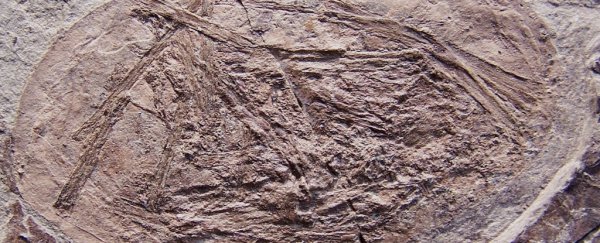Nearly 200 million years ago, Earth's skies were home to a creature unlike anything seen today. Neither bird nor dinosaur, this long-extinct reptile was, quite literally, born to fly.
A fresh look at the fossilised embryos of pterodactyls has revealed just how independent these so-called flaplings truly were.
Discovered in China for the first time back in 2004, the embryos of these unborn creatures were thought to have poorly developed wings, and this had convinced some scientists that pterodactyl hatchlings required extended parental care before they could even dream of spreading their wings.
Palaeobiologist David Unwin and zoologist Charles Deeming now think they've disproved this hypothesis.
"By contrast, we have argued that pterosaurs were capable of flight soon after hatching and probably did not require parental care, implying a profoundly different life-history mode for pterosaurs, compared to that of extant fliers," the authors write.
While previous studies on pterodactyl flaplings have tended to rely on qualitative assertions only, the new study uses multiple lines of evidence to show that some eggs and embryos should be reassigned to earlier stages.
Examining the limb length, egg size, and egg shape of all known embryos to date - including a fossil cache in China containing hundreds of eggs - the researchers compared pterodactyl growth to modern-day birds and crocodiles.
Amongst their findings, they identified examples of early- and middle- as well as late-stage embryonic pterodactyls, which had died just before they hatched.
Once they'd been slotted into these categories, the team examined various stages of bone formation, or ossification, in nine different species of pterodactyl (Hamipterus).
In particular, there was one bone that stood out: the manus digit IV. This is what we call the ring finger in humans, and it's known as the "wing finger" in birds and pterodactyls. As one of the last bones to harden, it's a key "developmental marker".
The early development, and elongation of these bones, the authors argue, show "unique components of the pterosaur [body plan] were present at the earliest stages of skeletal formation and acted as anatomical precursors to the final stages of prenatal development."
Gathering all these details together, the new paper claims that pterosaurs were "flight capable at a very early stage in their postnatal development".
While this doesn't necessarily mean that the reptile flaplings did not receive parental care in some form - for instance, as protection from predators - the authors say there is no direct evidence to support the idea that they needed their parents to help them fly.
"It's extremely unlikely that they would equip themselves with a flight apparatus if they were not going to use it," Unwin told The New York Times. "What do you need mummy and daddy for if you can do everything yourself?"
Not everyone agrees. While some scientists were convinced of the arguments, others have called this new hypothesis a stretch, or have qualms with some of the specifics.
Whether the idea stands up to further scrutiny remains to be seen. Whatever conclusion we ultimately land on, it will have a profound impact on our understanding of how pterodactyls once lived and flew in a time very distant from our own.
The research was published in Proceedings of the Royal Society B.
